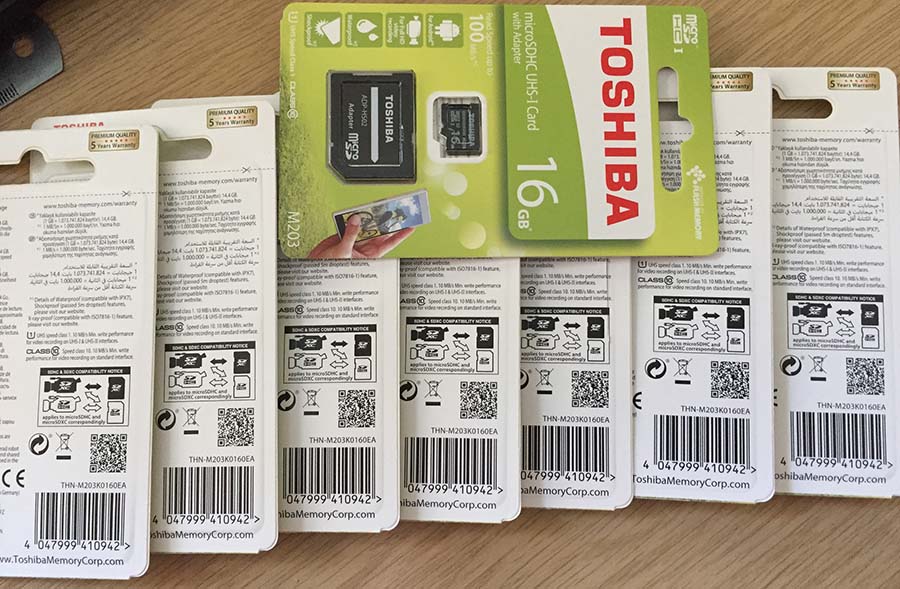Raspberry Pi3 alternative?
-
@bjacobse Had considered that to begin with and concluded the Pi3 did the same, only a UPS and HDD to complete.
Essentially it was the quirks of the Pi3 and unfamiliarity with Linux I struggled with and still do, but it still appears to be the best solution.
My complacency over the external HDD relieving the common failure of microSD on power outages has certainly returned to haunt me.Time to order the UPS parts and delve into Linux learning I guess, then start over if I can't recover what's on the HDD...
@zboblamont
I use a RPI3 and use this UPS (powerbank + script), as it's cheap and useful
http://raspi-ups.appspot.com/en/index.jsp -
Or get a real UPS. For 95 euros you can buy a 8-socket power plug with built in battery that can power your router, raspberry pi and other devices for about 15 minutes. You can even control it via USB. That's what I use.
https://duckduckgo.com/?q=APC+Back-UPS+ES+8&t=ffab&ia=web
It's pretty great when the power goes out and you can still use your laptop to go online as if nothing has happened.
-
Thanks @bjacobse @alowhum , the UPS parts should arrive tomorrow, and be on safer ground in a couple of days. 7.2Ah at 12v with buck converter should cover the bulk of the outages, will look at a shutdown procedure later for the loner ones.
Lesson learned, no idea yet if the database can be salvaged from the corrupted drive. Pi rebuilt on Buster with a fresh drive, just Domoticz to reinstall once UPS is running. -
Thanks @bjacobse @alowhum , the UPS parts should arrive tomorrow, and be on safer ground in a couple of days. 7.2Ah at 12v with buck converter should cover the bulk of the outages, will look at a shutdown procedure later for the loner ones.
Lesson learned, no idea yet if the database can be salvaged from the corrupted drive. Pi rebuilt on Buster with a fresh drive, just Domoticz to reinstall once UPS is running.@zboblamont A cheap and silent alternative could be one of this qotom mini pc.
I'm using one of this as a virtual machine server with proxmox since 2-3 years and I'm very happy with it.
One of the vm is running pfsense so it act also as a main router / firewall for the entire Lan.
The backup of a vm is super easy 😉 but the initial setup of the environment requires a bit of Linux learning
-
Or get a real UPS. For 95 euros you can buy a 8-socket power plug with built in battery that can power your router, raspberry pi and other devices for about 15 minutes. You can even control it via USB. That's what I use.
https://duckduckgo.com/?q=APC+Back-UPS+ES+8&t=ffab&ia=web
It's pretty great when the power goes out and you can still use your laptop to go online as if nothing has happened.
@alowhum said in Raspberry Pi3 alternative?:
for about 15 minutes.
Haha don't move to Vietnam, here when they cut power it can last half a day.
@bjacobse said in Raspberry Pi3 alternative?:
I use a RPI3 and use this UPS (powerbank + script), as it's cheap and useful
http://raspi-ups.appspot.com/en/index.jspDo you also use the ethernet switch as a power sensor ? :D I would just use an USB splitter before the powerbank, then use one wire and a voltage divider to connect it directly to a GPIO...
-
@zboblamont
I use a RPI3 and use this UPS (powerbank + script), as it's cheap and useful
http://raspi-ups.appspot.com/en/index.jsp@bjacobse what powerbank are you using? The one referenced on http://raspi-ups.appspot.com/en/index.jsp is no longer available, and according to https://www.raspberrypi.org/forums/viewtopic.php?t=144621 that bank automatically shuts off when the Raspberry Pi draws too little current.
-
@bjacobse what powerbank are you using? The one referenced on http://raspi-ups.appspot.com/en/index.jsp is no longer available, and according to https://www.raspberrypi.org/forums/viewtopic.php?t=144621 that bank automatically shuts off when the Raspberry Pi draws too little current.
-
My solution to the problem is to use OverlayFS, AND make sure i clone and replace the SD card every 2-3 years. This method
writes/syncs modified data to SD card only on reboots.Hourly backups are rsynced to another PI.
UPS is recommended but not a must
-
@alowhum said in Raspberry Pi3 alternative?:
for about 15 minutes.
Haha don't move to Vietnam, here when they cut power it can last half a day.
@bjacobse said in Raspberry Pi3 alternative?:
I use a RPI3 and use this UPS (powerbank + script), as it's cheap and useful
http://raspi-ups.appspot.com/en/index.jspDo you also use the ethernet switch as a power sensor ? :D I would just use an USB splitter before the powerbank, then use one wire and a voltage divider to connect it directly to a GPIO...
@nca78 said in Raspberry Pi3 alternative?:
Do you also use the ethernet switch as a power sensor ? :D I would just use an USB splitter before the powerbank, then use one wire and a voltage divider to connect it directly to a GPIO...
There are typically many paths to same solution :-)
It was easiest for me to just copy exact same setup - why should I bother to purchase an USB splitter and spend time to setup a voltage divider and create a script that needed to measure voltage on a GPIO -
@bjacobse what powerbank are you using? The one referenced on http://raspi-ups.appspot.com/en/index.jsp is no longer available, and according to https://www.raspberrypi.org/forums/viewtopic.php?t=144621 that bank automatically shuts off when the Raspberry Pi draws too little current.
@mfalkvidd
The powerbank I am using is a Linocell 7800mA. YES I AM AWARE that it's stated on the powerbank that it's not allowed to both charge powerbank an use it as powerbank - But that is exactly what I do ;-)
Bought here:
https://www.kjell.com/se/produkter/hem-kontor-fritid/fritid/resetillbehor/powerbank/linocell-3x-dual-powerbank-7800-mah-bla-p96870 -
@nca78 said in Raspberry Pi3 alternative?:
Do you also use the ethernet switch as a power sensor ? :D I would just use an USB splitter before the powerbank, then use one wire and a voltage divider to connect it directly to a GPIO...
There are typically many paths to same solution :-)
It was easiest for me to just copy exact same setup - why should I bother to purchase an USB splitter and spend time to setup a voltage divider and create a script that needed to measure voltage on a GPIO@bjacobse said in Raspberry Pi3 alternative?:
@nca78 said in Raspberry Pi3 alternative?:
Do you also use the ethernet switch as a power sensor ? :D I would just use an USB splitter before the powerbank, then use one wire and a voltage divider to connect it directly to a GPIO...
There are typically many paths to same solution :-)
It was easiest for me to just copy exact same setup - why should I bother to purchase an USB splitter and spend time to setup a voltage divider and create a script that needed to measure voltage on a GPIOIt's just that it looks like a serious overkill and cable mess to use an ethernet splitter + it's own supply + ethernet cable when it can be done with less than 1$ of hardware and only one splitter + one spare usb cable. But that's just my own opinion :)
And if you want to really go for cheap and easy solution the raspi ups hat (blue PCB like in the link below) works like a charm. Compact, efficient, no extra cable. And I think the price is even cheaper than powerbank + splitter.
https://www.aliexpress.com/item/32882666003.html -
Wasn't where I was headed with the topic, but some interesting future considerations developed...
UPS - I went with the AD-55A, 7.2Ah cell and buck converter previously suggested elsewhere, WAY bulkier than the HAT arrangement which tempted, and may yet be deployed as a secondary safety.
What I found particularly infuriating was commercial UPS offerings mis-stating and misleading available USB current output, clearly targeting phone charging as a marketing ploy to expand their legacy constant dual voltage conversion lines without really developing anything new. Compared to these my own UPS will beat them in efficiency by a country mile as it's not designed from the ground up as dedicated dual conversion.
Aside the various HAT variants, there has not been minimal attention paid to more efficient UPSs for 5v etc devices despite an exponential increase in their deployment...
It is a little ironic really that this community has squeezed every Joule out of battery conservation on Nodes (my Gas meter is now passed year two on two AA alkaline :smile: ) yet reliance on a constant electrical supply remains for the Controller.
Perhaps French, German and Dutch supplies are more reliable, but here in Romania, "Vorsprung durch fuckup" prevails :smirk: -
@bjacobse said in Raspberry Pi3 alternative?:
@nca78 said in Raspberry Pi3 alternative?:
Do you also use the ethernet switch as a power sensor ? :D I would just use an USB splitter before the powerbank, then use one wire and a voltage divider to connect it directly to a GPIO...
There are typically many paths to same solution :-)
It was easiest for me to just copy exact same setup - why should I bother to purchase an USB splitter and spend time to setup a voltage divider and create a script that needed to measure voltage on a GPIOIt's just that it looks like a serious overkill and cable mess to use an ethernet splitter + it's own supply + ethernet cable when it can be done with less than 1$ of hardware and only one splitter + one spare usb cable. But that's just my own opinion :)
And if you want to really go for cheap and easy solution the raspi ups hat (blue PCB like in the link below) works like a charm. Compact, efficient, no extra cable. And I think the price is even cheaper than powerbank + splitter.
https://www.aliexpress.com/item/32882666003.html@nca78
I think you must have misunderstood the concept. I did not use a ethernet splitter and extra cable mess...
I use my router as IP supplier, 1 ethernet cable to my RPI, so I have cable to my domoticz, the RPI gets IP via cable, and if the I'm not able to ping gateway (router) then there is no power as the gateway is down.
the ONLY extra thing I have purchased is a the powerbank :-) -
@bjacobse said in Raspberry Pi3 alternative?:
@nca78
I think you must have misunderstood the concept. I did not use a ethernet splitter and extra cable mess...
I use my router as IP supplier, 1 ethernet cable to my RPI, so I have cable to my domoticz, the RPI gets IP via cable, and if the I'm not able to ping gateway (router) then there is no power as the gateway is down.
the ONLY extra thing I have purchased is a the powerbank :-)Indeed I misunderstood, it makes much more sense like that :)
@zboblamont said in Raspberry Pi3 alternative?:
Perhaps French, German and Dutch supplies are more reliable, but here in Romania, "Vorsprung durch fuckup" prevails
Same here in Vietnam... That's why I'll also have a wifi gateway with battery backup soon.
-
i know this is old thread but here is what i have to deal with, truck load of different sd card ordered from amazon from different supplier, some full filled by amazon and some sold by amazon and all of them are fake and devil is in serial number so until you order more then one SD card you can never know if its real or fake.





-
i know this is old thread but here is what i have to deal with, truck load of different sd card ordered from amazon from different supplier, some full filled by amazon and some sold by amazon and all of them are fake and devil is in serial number so until you order more then one SD card you can never know if its real or fake.





@pihome It's a nightmare even for reputable stores. Bought an expensive Samsung thinking it would be reliable, turned out to be fake. Store wasn't happy when I asked for money back.
-
may be its time for Raspberry pi foundation to put some storage on the board, these fake cards are very unreliable and i think small pc is better option then Raspberry pi at this stage.
@pihome I gave up and used a laptop hdd, a little bulkier but no regrets..
-
It seems to be me the issue is buying fake SD cards. How do you even get in that situation? Do you buy them from China?
-
It seems to be me the issue is buying fake SD cards. How do you even get in that situation? Do you buy them from China?
